During the coronavirus pandemic, the real estate market is both busy and not busy.
Open houses (virtual or in person) are still happening and views on HAR.com are up 66 percent, but closings have decreased substantially since mid-March and were down 20.2 percent for the week ending June 8, compared to the same week a year ago, according to the Houston Association of Realtors. Adding to the problem, the average time on market was up by four days to 58.
Jeremy Fain, a realtor at Greenwood King Properties, said sellers want the best price, of course, but they also want to sell quickly. Spec home builders are in the same boat — hoping to sell quickly to curb interest costs and boost profits.
One way to get a home sold more quickly is to have it ready for a buyer, even if it means hiring a staging company to help you make decisions, declutter and decorate.
“You can look at houses with days on market that are completely vacant and houses that are staged, and the days on market are drastically less. Staged houses always sell faster,” said Fain on a recent visit to a 3,600-square-foot Museum District home that’s about to go on the market for $1,250,000.
“The National Association of Realtors does a study every year, and typically, a home will spend 60 to 80 percent less time on the market if it’s staged,” said Pratt Barndollar, who runs Showhomes Houston staging company with his wife, Shelley. “Once a year we look back at homes we staged and their time on market compared to comps, and that’s what we find as well.”
When you hire a home staging expert, they’ll visit your home to assess what you have, what needs to go and what they need to bring in. They’ll likely recommend if you need to paint or clean carpet or other flooring and, of course, they’ll tell you to get rid of clutter and clean out closets. If you can’t do these things yourself, they often can recommend professionals they’ve worked with and trust.
Potential home buyers aren’t buying your belongings, but when they look in a room or closet, they want to see how big it is — not how full it can be.
The Barndollars, Cindy Witmer of Cindy Witmer Designs and Walker Wright of Walker Wright Abodes all agreed that staging a home for sale is dramatically different from decorating a home you plan to live in.
While home decorating is about your own taste and personality, staging is getting complete strangers to imagine how they’d live in your home.
Here are 10 tips from the Barndollars, Witmer and Wright.
1. Clean lines
One of the most important elements of your décor — regardless of style — is that you have clean lines. That means lighter colors and less ornamentation and fewer fussy pieces of furniture to make your home feel more current and on-trend. Remove some furniture if that’s what it takes for people to move freely from room to room.
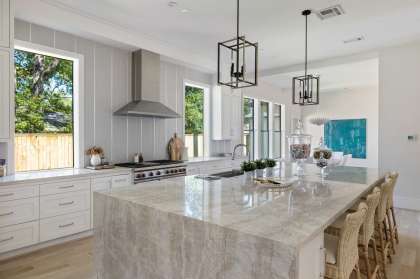
2. Warmth
Homes that feel too spare, too white or too empty will feel “cold.” Add warmth with natural materials such as bamboo, wood or textured hair-on hide and plants or flowers anywhere.
If you’re not able to keep plants watered and flowers fresh, opt for high-quality fakes. It’s easy to find faux succulents, orchids and boxwood that look like the real deal.
In a brand new spec home, Witmer added wicker and bamboo barstools and a trio of faux boxwood topiaries to an island in a kitchen that looked pristine but had lots of hard materials
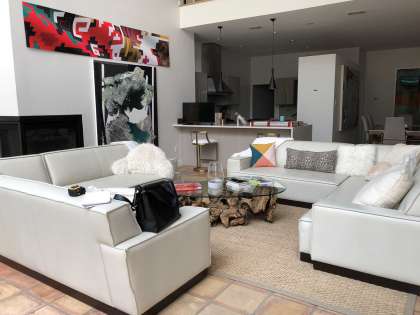
3. First focus
Don’t skimp on the first rooms a potential buyer will see when they come in your home, even if they’re the dining room or a home office. Aside from the exterior curb appeal, these rooms set the tone for the rest. Stage your dining room without a rug to help the space look larger and make sure the table is the right size for the room.
Witmer and Wright recently styled a Bunker Hill home using dining chairs upholstered in blush-colored fabric. The chairs were so gorgeous that you barely noticed what the table looked like.
“The table had a glass top, which makes the chairs stand out so much,” Witmer said. “The problem is, chairs can be really expensive and you need so many of them. But there are so many copies out there that you don’t have to buy the most expensive version.”
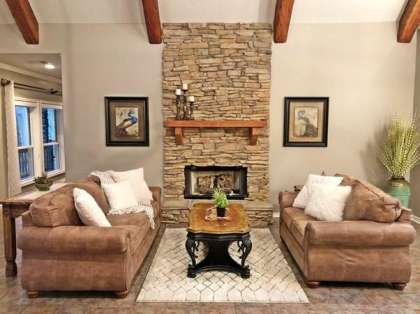
4. Opt for better lighting
While builders often see expensive lighting as something that simply diminishes their profit, better light sells a home.
“When we went in this house, the fixtures were cheapening the house — and it’s a $3 million house. People shopping in that price range will notice,” Witmer said. “It’s a real mistake to go cheap on lighting. Of course (a buyer) can come in and put in their own, but why?”
So if you’re getting your own home ready for the market, look at your lighting and ask if it’s dated and worn. If it is, consider replacing it with something on-trend and distinctive, she said.
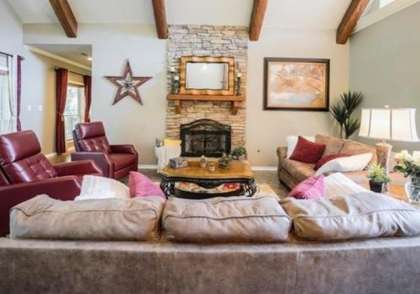
5. Primary bedroom
Staging a primary bedroom is about making the room feel like a warm, welcoming retreat. If the room is large, arrange furnishings to show how the space can be used: where the bed should be placed and how you can add a sofa or chairs and an accent table.
While staging calls for fewer rugs than interior designers use, a rug under the bed in a primary bedroom can make it feel relaxing and inviting. Make the bed completely, but don’t overdo it: nice bedding, pillows for sleeping and a few decorative pillows. Avoid overly fluffy bedding and layers of pillows — that might look pretty, but it will likely make a homeowner think “I could never do that.”
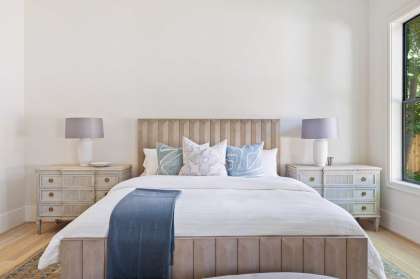
6. Remove clutter
Marie Kondo has had America on a decluttering binge for a couple of years, and it will also help prepare your home for sale. Witmer said closets should be clean and orderly, with a reasonable amount of clothes arranged by color and everything on matching, flocked hangers. A messy mud room is a turnoff to buyers, so clean it up.
In a bathroom, edit toward minimalism. Witmer likes to use chic Turkish towels, and Shelley Barndollar avoids using rugs because they “eat up visual space” and can make a bathroom look smaller. If the bathroom is larger, use pretty toiletries on a tray on a makeup vanity or put pretty soaps on a small accent table by a bathtub.
Accessories such as books or knickknacks throughout your home should be edited with a less-is-more approach. You’re showing off how much room you have, not how much you can put in it. A few family photos are fine, but if you have them in every room, pack up most of them and save them for your next home.
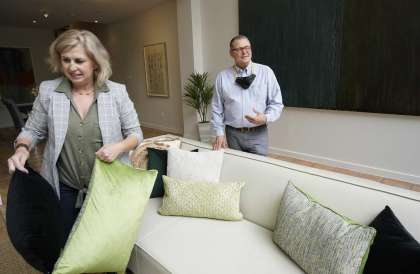
7. Window treatments
Nothing warms up a room faster than nice draperies, but other things are more important. Dark, heavy and overly embellished window treatments will look dated and will not help your home sell more quickly.
Bare windows can show how much natural light comes in or showcase a nice view. If you want to have window treatments, you can’t go wrong with seagrass shades or linen draperies in lighter colors.
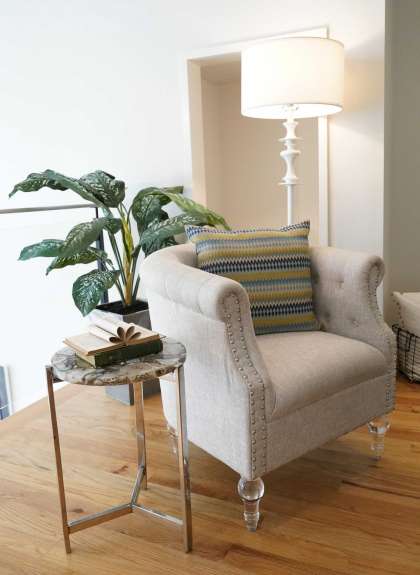
8. Rugs
When designing your home for yourself, rugs are important. When staging a home, though, you want as few as possible. The Barndollars, Witmer and Wright all said rugs should be kept to a minimum. Don’t use them in kitchens, dining rooms or bathrooms.
In a primary bedroom or living room, though, they can help define seating areas. Just make sure they are light in color and blend with the floor underneath.
In the Museum District home the Barndollars recently staged, a previous homeowner installed yellow-orange Saltillo tile throughout the main floor. It’s look is dated and didn’t fit with the more modern style of the home, but the homeowner loved it. Shelley Barndollar placed a large sisal rug in the living room and removed some of the furniture to make the space feel larger and help tone down the color of the floor.
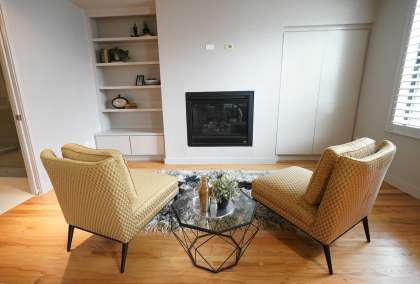
9. Spaciousness
Most homeowners have too much furniture in their rooms, especially family and living rooms. If sofas, chairs and tables eat up space and make it hard to walk around, you’ll want to remove some of it to show how large your room really is.
“When in doubt, leave it out is the rule we follow,” said Pratt Barndollar. “Not every wall or corner needs a piece of art or furniture. Ask ‘is this piece making the room better?’ Often it’s not. We want to reduce distractions.”
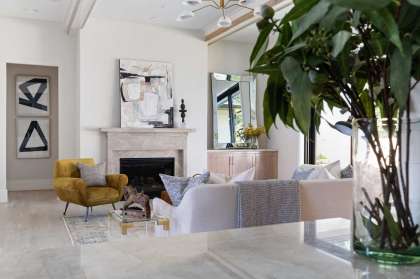
10. Scent
Witmer offered a final, obvious tip. Make sure your home smells good. Candles and home fragrances are important, but keep the scent simple and clean. Anything called “rain,” “cotton” or “linen” is sure to work.
diane.cowen@chron.com
Sign up for Cowen’s Access Design newsletter, delivered to your inbox Tuesdays, at houstonchronicle.com/accessdesign.




